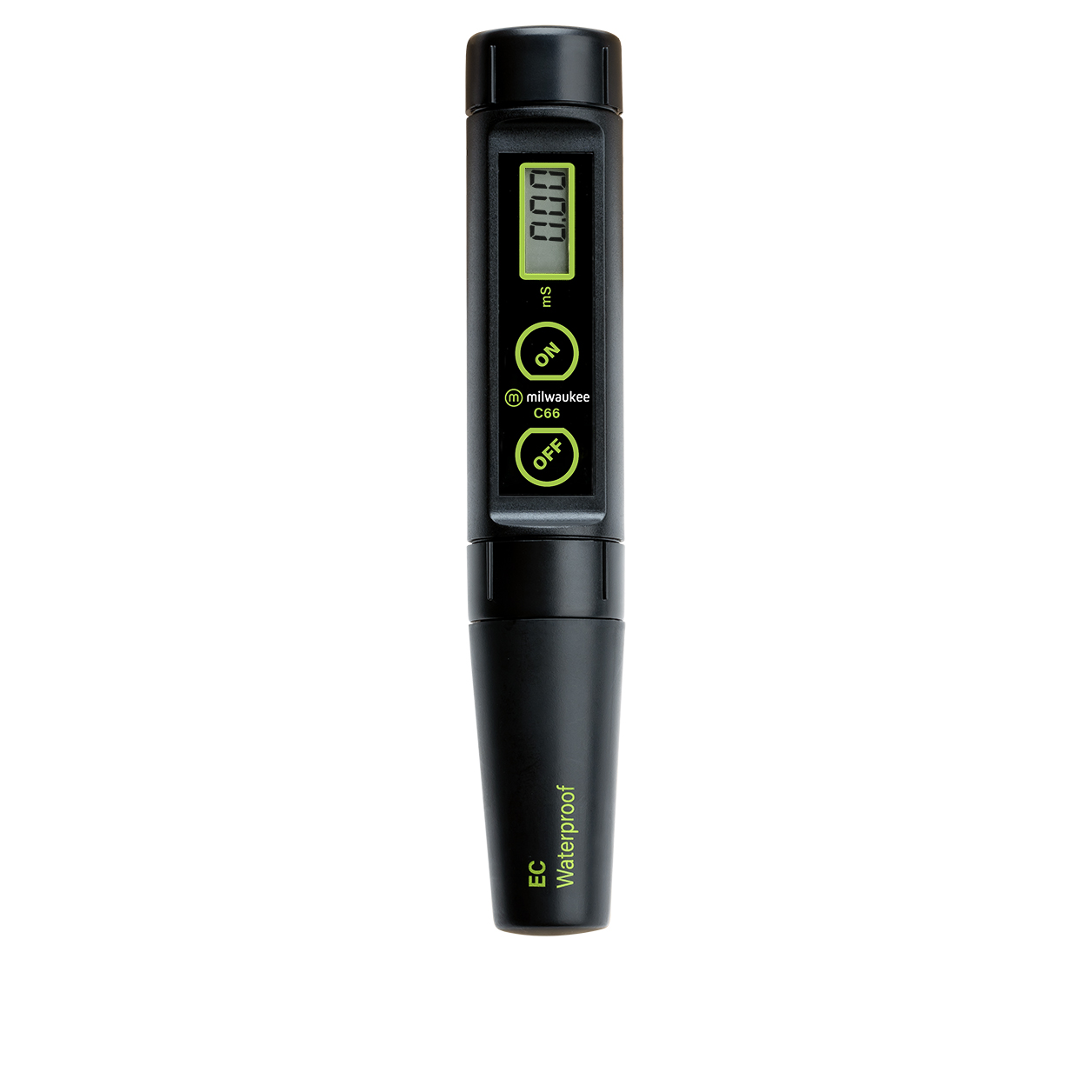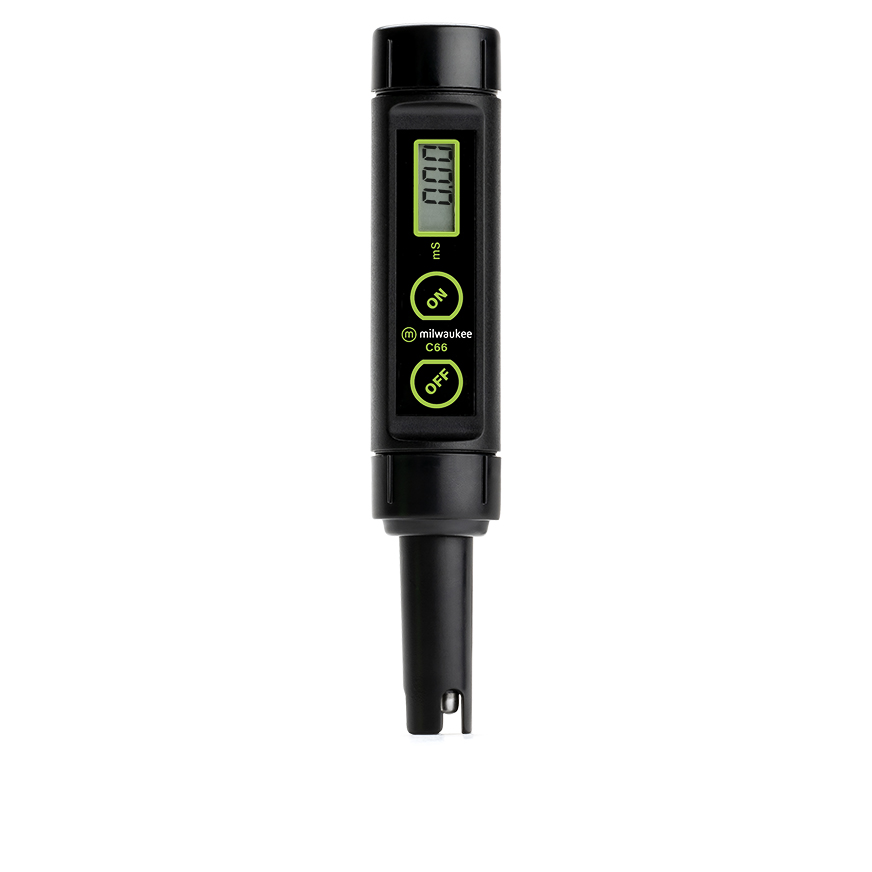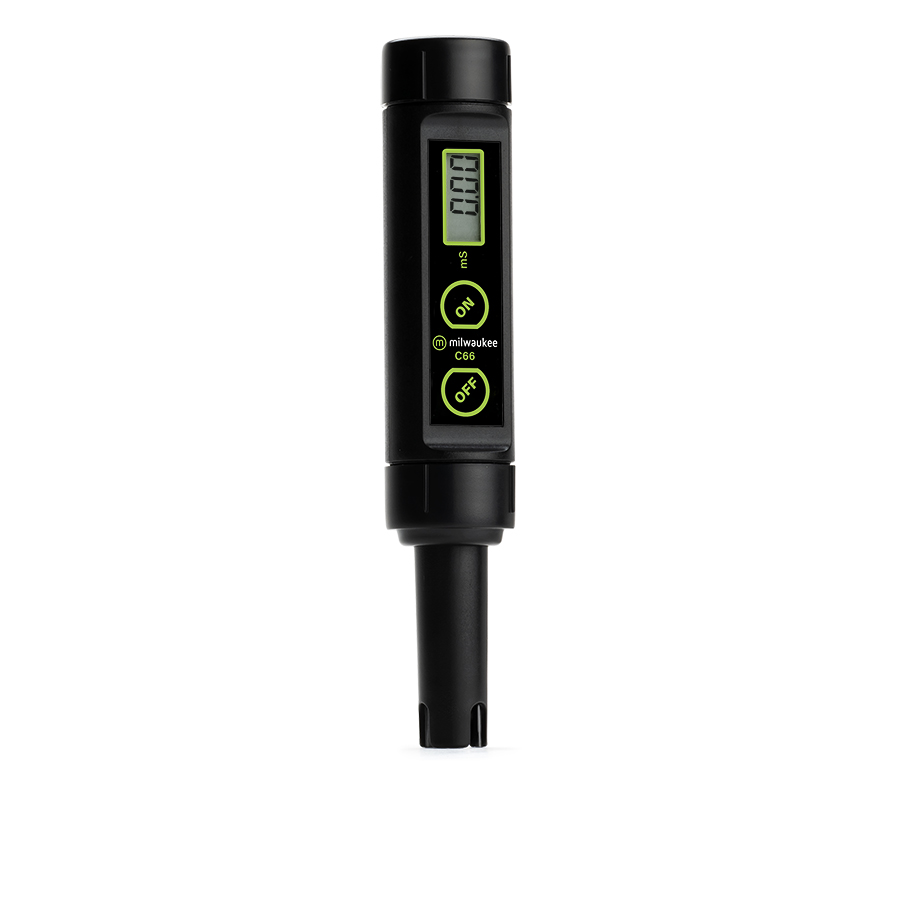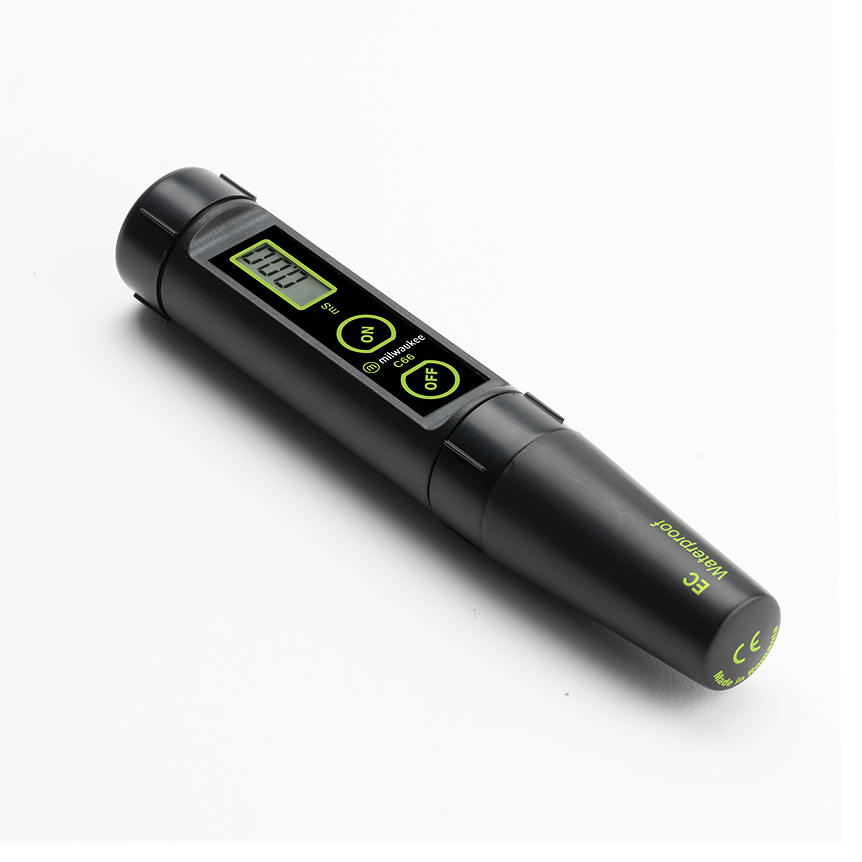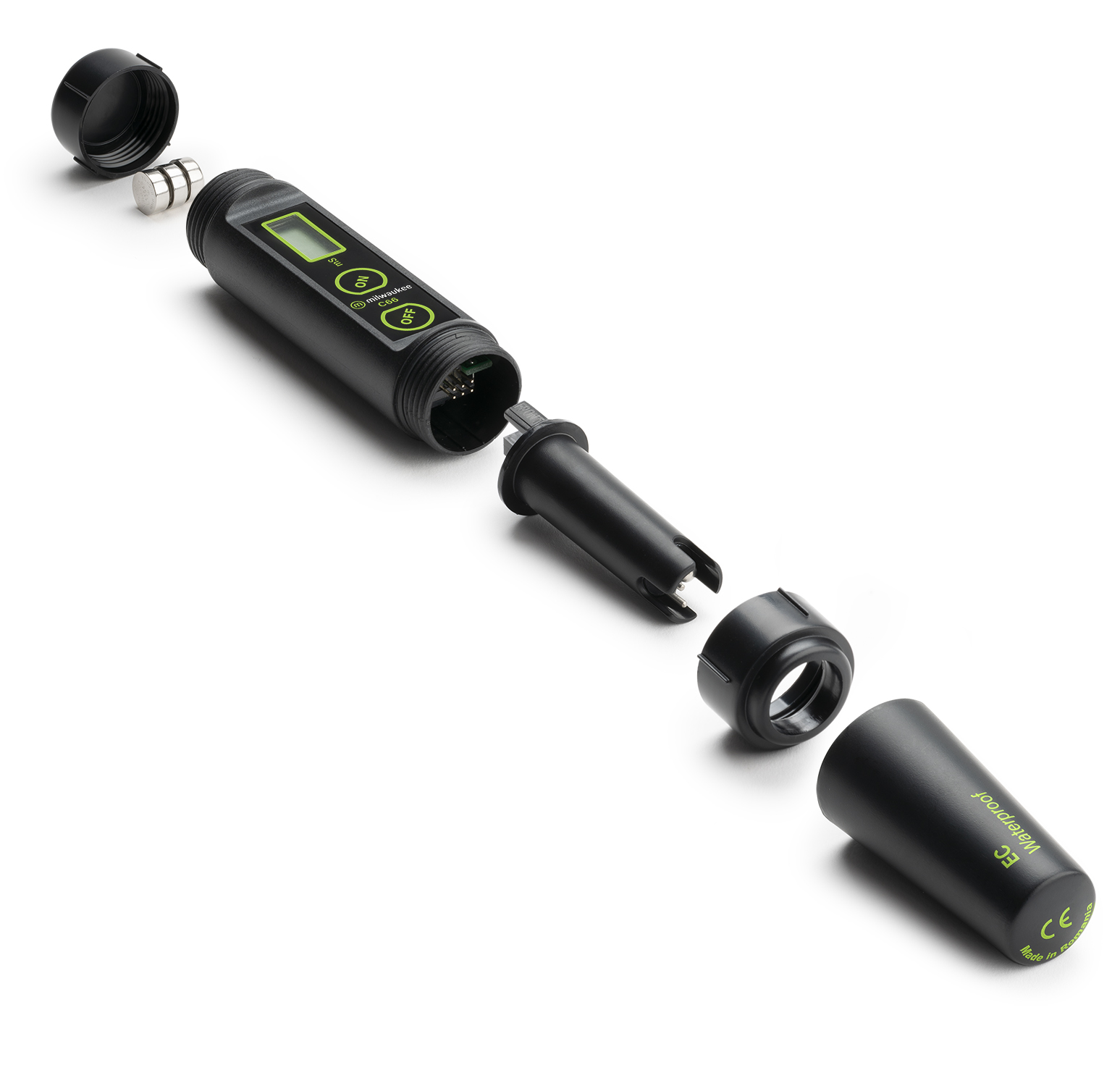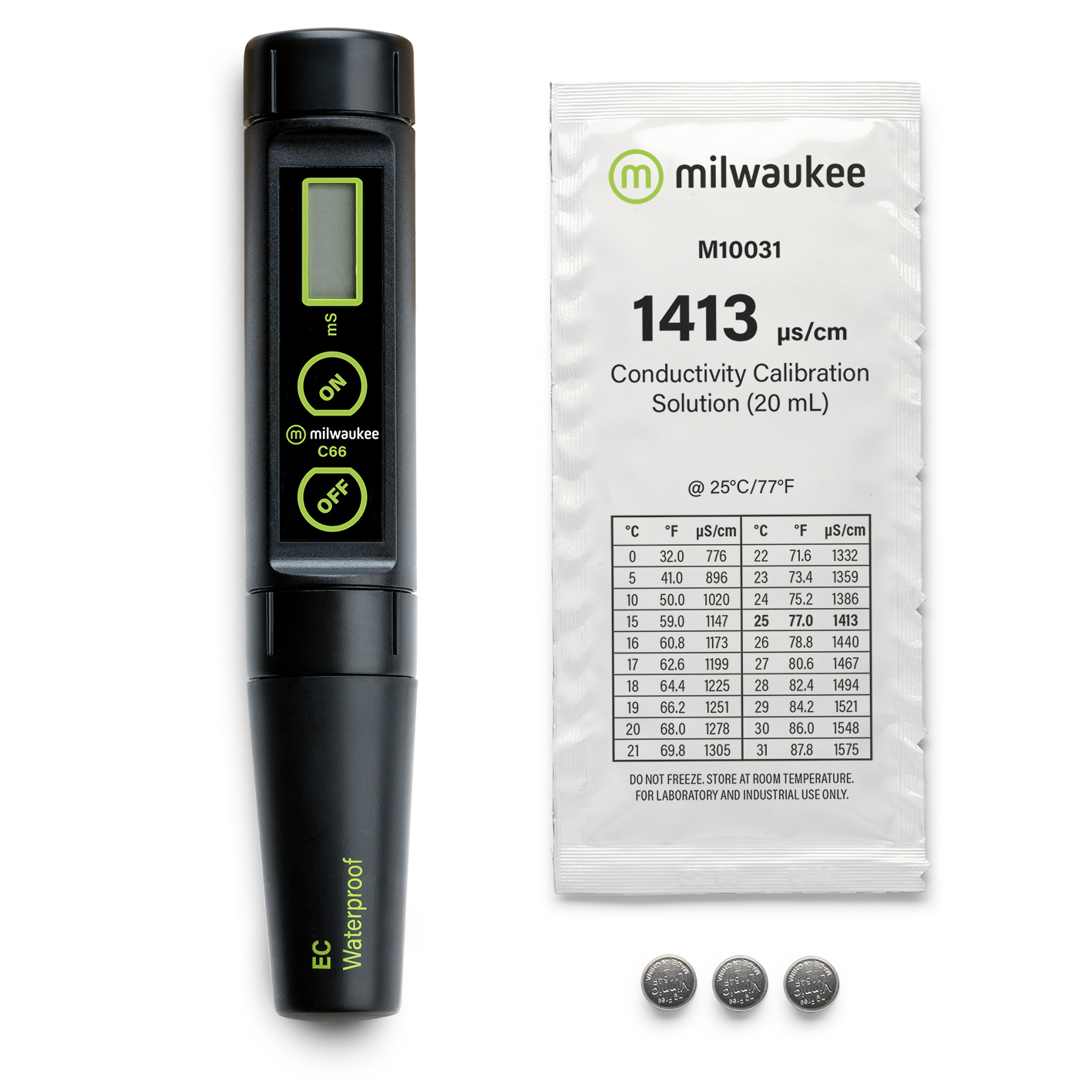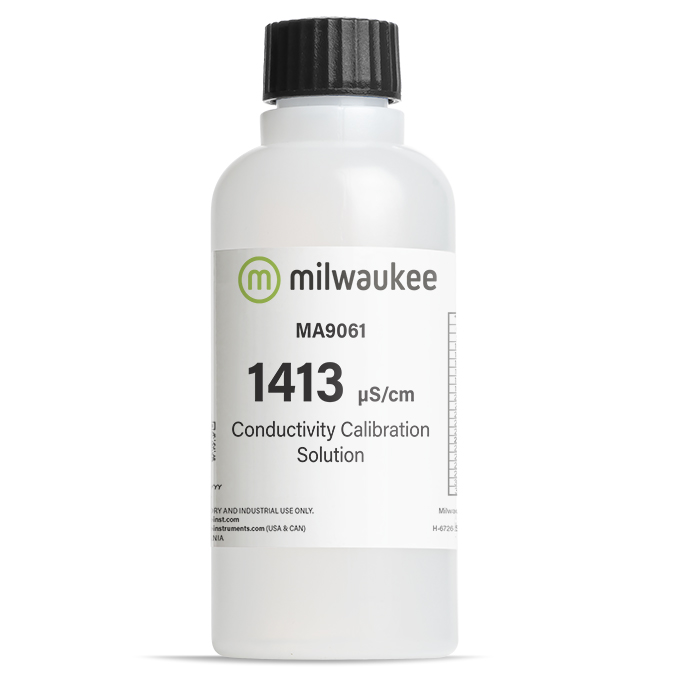Your shopping cart is currently empty.
€48.13
Milwaukee C66 Waterproof High Range Conductivity Pen with ATC and Replaceable Electrode
Milwaukee C66 Waterproof EC Tester – Compact Precision for High-Range Conductivity Monitoring
In fast-paced, high-performance environments – from hydroponic farms and greenhouses to aquaculture systems, pools, and industrial water treatment facilities – knowing the exact electrical conductivity (EC) of your water isn’t just helpful; it’s critical. The Milwaukee C66 Waterproof EC Tester is designed to be your go-to, on-the-spot solution for accurate, high-range EC measurements. Whether you're fine-tuning nutrient levels in a hydroponic tank or monitoring salt buildup in aquaculture, the C66 brings lab-quality accuracy straight to your fingertips.
This portable and rugged tester is ideal for professionals and hobbyists alike. Built for demanding fieldwork, the C66 is fully waterproof (IP67 rated), features a replaceable EC electrode, and offers automatic temperature compensation for accurate readings even in fluctuating environments. With a measurement range of 0.00 to 10.00 mS/cm, it covers a wide spectrum of applications where salinity or dissolved salt levels are crucial for performance, health, or compliance.
The C66 isn't just a tool – it’s a daily companion for quality assurance. Slip it in your pocket, take it to the field, and trust that your readings will help you make informed decisions every time. Whether you're growing crops, raising fish, purifying water, or running a pool, the Milwaukee C66 ensures you stay in control.
Why Choose the Milwaukee C66?
- Wide Measurement Range: Measures EC from 0.00 to 10.00 mS/cm, ideal for a broad variety of water and nutrient solutions.
- Replaceable EC Probe: Extend the life of your tester with easily replaceable electrodes, keeping your investment lasting longer.
- Waterproof & Durable: IP67-rated casing makes it perfect for wet, demanding environments.
- Automatic Temperature Compensation (ATC): Ensures accurate EC readings even when water temperature varies.
- One-Point Manual Calibration: Simple and quick calibration process for reliable, repeatable accuracy.
- Compact and Lightweight: Pocket-sized design makes it easy to carry and use anywhere, anytime.
- Battery Life Indicator & Auto-Off: Preserves battery life with an automatic shutoff feature and clear power status.
Applications:
Hydroponics and Agriculture: Essential for monitoring nutrient concentrations in soil and hydroponic systems to ensure optimal plant growth.
Aquaculture and Aquariums: Used to maintain appropriate water quality by measuring dissolved salts, ensuring a healthy environment for aquatic life.
Water Treatment and Wastewater Management: Assists in assessing the conductivity of water to determine the level of impurities or salinity, crucial for treatment processes.
Food and Beverage Industry: Applied in quality control processes to measure the ionic content in products, ensuring consistency and safety.
Educational and Laboratory Research: Serves as a practical tool for teaching and research purposes, allowing students and researchers to conduct experiments involving solution conductivity.
Swimming Pools and Spas: Helps in monitoring and maintaining the correct chemical balance in recreational water facilities.
Proper Care & Maintenance
To keep your Milwaukee C66 performing at its best:
- Rinse After Use: Always rinse the EC probe with distilled water after measurements to prevent salt and residue buildup.
- Calibrate Regularly: Perform regular one-point calibrations using EC calibration solutions to ensure consistent accuracy.
- Store Properly: Store the unit in a dry, cool place. Replace the probe cap after each use to protect the sensor.
- Replace the Electrode When Needed: If readings become unstable or calibration fails, it may be time to replace the electrode.
- Avoid Extreme Conditions: Keep the tester away from direct sunlight, excessive heat, and freezing temperatures.
· EC electrodes can develop nutrient build up over time. To miminize build up, always rinse the probe in fresh tap water after every use.
CONVERTING EC TO TDS
The Milwaukee EC Pen, like all conductivity meters, provides a measure of electrically charged ions in a solution and is an absolute measure of conductivity.
EC is often converted to TDS in parts per million (ppm). Different scales include the 500 scale, 650 scale and the 700 scale. However, true PPM can only be determined through chemical analysis.
Your mS/cm reading can be approximately converted to TDS (ppm) as shown in the examples below.
· 2.00 mS/cm = 2000 uS/cm = 1000 ppm on .50 factor scale
· 2.00 mS/cm = 2000 uS/cm = 1400 ppm on the 442 scale or .70 factor scale
Thank you for considering Milwaukee to help you take your results to the next level.
Specifications
Application
Hydroponics and Agriculture
In hydroponics and agriculture, nutrient concentration directly affects plant growth, yield, and overall health. Electrical conductivity (EC) is a key indicator of the total dissolved salts (TDS) or nutrient strength in your water or soil solution. If the EC level is too low, your plants may suffer from nutrient deficiencies; if it’s too high, it can lead to nutrient burn, stunted growth, or root damage.
The Milwaukee C66 Waterproof EC Tester provides growers with an accurate and easy way to monitor and adjust nutrient solutions. It allows for precise control of fertilizer dosing in hydroponic reservoirs and irrigation systems, helping you maintain the optimal balance for plant uptake. In traditional agriculture, it can also be used to assess soil salinity via soil leachate testing.
Whether you're growing leafy greens, tomatoes, cannabis, or ornamentals, maintaining the right EC level can make the difference between a healthy harvest and a disappointing one. With its wide measurement range (0.00 to 10.00 mS/cm), the C66 is ideal for crops at all stages of development – from seedlings requiring gentler solutions to mature plants needing full-strength nutrients.
How to Use the Milwaukee C66 in Hydroponics & Agriculture
1. Prepare Your Solution
· If using in hydroponics, stir the nutrient solution to ensure it's well mixed.
· If testing soil, prepare a soil leachate by mixing equal parts soil and distilled water, stir, and let it settle.
2. Turn On the Meter
· Press the power button on the C66. The display will activate instantly.
3. Rinse the Electrode
· Rinse the EC electrode with distilled water to avoid cross-contamination, especially if switching between samples.
4. Take a Reading
· Immerse the probe in the solution. Wait a few seconds for the value to stabilize.
· The temperature-compensated EC reading will appear on the display.
5. Record the Result
· Compare your result to target EC levels for your specific plant species and growth stage.
· Adjust nutrient concentrations accordingly.
6. Rinse and Store
· After testing, rinse the probe again with distilled water.
· Cap the electrode and store the tester in a cool, dry place.
Typical EC Ranges in Hydroponics (General Guide):
· Seedlings: 0.5 – 1.0 mS/cm
· Vegetative Stage: 1.2 – 2.0 mS/cm
· Flowering/Fruiting: 1.8 – 2.5 mS/cm
Note: Always refer to crop-specific EC guidelines for best results.
Aquaculture, Aquariums & Aquaponics
Water quality is the foundation of healthy aquatic life. In aquaculture systems, home or professional aquariums, and aquaponic setups, one of the most important parameters to monitor is electrical conductivity (EC) – a measure of the dissolved salts and ions in the water. These salts include minerals essential for fish health, such as calcium, magnesium, sodium, and potassium.
In aquaculture, stable EC levels support fish metabolism, growth, and stress resistance. Sudden changes or excessively high EC can stress fish, hinder osmoregulation, or signal contamination. For freshwater species like tilapia, carp, or ornamental fish, keeping EC within a safe range ensures optimal living conditions.
In aquaponics, where aquaculture is integrated with hydroponic plant growth, EC plays a dual role. It helps assess whether:
- Fish waste is producing enough nutrients for the plants, and
- The overall nutrient load remains within safe limits for the fish.
The Milwaukee C66 EC Tester is a vital tool for these systems, providing fast, accurate readings on-site. With a wide range (0.00 to 10.00 mS/cm) and waterproof design, it’s ideal for environments where reliability and portability are essential.
How to Use the Milwaukee C66 in Aquatic Systems
- Ensure Water Circulation
- Take your EC reading from a well-mixed area of the tank or system, preferably near water inflow or pumps to get a representative sample.
- Turn on the Meter
- Press the power button to activate the Milwaukee C66.
- Rinse the Electrode
- Before each use, rinse the electrode with distilled or deionized water to avoid contamination.
- Immerse the Probe
- Dip the EC sensor into the water. Make sure the electrode is fully submerged.
- Wait a few seconds for the reading to stabilize.
- Note and React
- Record the EC value and compare it to ideal ranges:
Freshwater aquariums: typically 0.2 – 2.0 mS/cm depending on species
Brackish aquariums: 5.0 – 15.0 mS/cm
Aquaponics systems: 0.5 – 2.0 mS/cm (depending on plant and fish species)
- Adjust salinity, mineral supplements, or system inputs accordingly.
- Rinse and Store
o After use, rinse the electrode again with distilled water and replace the protective cap.
o Store the meter in a cool, dry location.
Tips for Best Results:
· Test EC daily or weekly, depending on the system size and species sensitivity.
· Pair EC monitoring with pH and temperature checks for a full water quality profile.
· In aquaponics, track trends over time to ensure nutrient consistency for both plants and fish.
Water Treatment & Wastewater Management
In water treatment and wastewater management, electrical conductivity (EC) serves as a fast, reliable indicator of the total ion concentration – that is, the number of dissolved salts, minerals, and other charged particles in the water. High conductivity often indicates high salinity or contamination from industrial discharge, agricultural runoff, or domestic wastewater. Low conductivity, on the other hand, can suggest overly purified water or insufficient mineral content.
Monitoring EC helps operators:
- Evaluate raw water quality before treatment.
- Track the effectiveness of filtration, softening, or reverse osmosis systems.
- Ensure effluent (discharged water) meets environmental and regulatory standards.
- Detect leaks or system inefficiencies by spotting unexpected changes in EC levels.
The Milwaukee C66 Waterproof EC Tester is ideal for these tasks thanks to its wide range (0.00 to 10.00 mS/cm) and automatic temperature compensation, allowing technicians to obtain accurate, real-time measurements in a variety of field or facility conditions. Its compact, waterproof design makes it perfect for in-line spot checks, environmental sampling, or routine process control in both municipal and industrial treatment facilities.
How to Use the Milwaukee C66 in Water Treatment & Wastewater Management
- Identify the Sampling Point
- Choose a representative point in the treatment process (e.g., influent, post-filtration, post-reverse osmosis, or final effluent).
- If collecting a sample, use a clean container free from contamination.
- Power On the Tester
- Press the C66’s power button to turn the unit on.
- Prepare the Electrode
- Rinse the EC electrode with distilled or deionized water before immersing it in a new sample to avoid cross-contamination.
- Take the Measurement
- Immerse the probe in the sample or hold it directly in the water stream.
- Ensure the sensor is fully submerged and wait a few seconds for the reading to stabilize.
- Interpret the Results
- Typical EC levels:
- Drinking water: 0.05 – 0.75 mS/cm
- Untreated wastewater: 1.0 – 5.0 mS/cm or higher
- Treated effluent: 0.2 – 2.0 mS/cm (varies by regulation and discharge standards)
- Use the results to assess treatment efficiency or identify process issues.
- Clean and Store
- After use, rinse the probe with distilled water.
- Cap the electrode and store the tester in a dry, safe place.
Tips for Water Professionals:
- Regular EC monitoring allows early detection of anomalies or system failure.
- Pair EC with pH, turbidity, and TDS measurements for a more complete analysis.
- Use the C66 as a quick field tool to complement lab-based testing for faster decision-making.
Food & Beverage Industry
In the food and beverage sector, quality control is everything – and electrical conductivity (EC) plays a crucial role in ensuring product consistency, taste, texture, and regulatory compliance. EC measurement reflects the ionic content (dissolved salts, acids, bases, and minerals) in a sample, which directly influences flavor, shelf life, fermentation processes, and microbial stability.
The Milwaukee C66 EC Tester is widely used in:
- Beverage production (e.g., juices, soft drinks, mineral water) to maintain uniform mineral content and ensure batch-to-batch consistency.
- Fermentation monitoring in brewing, winemaking, and dairy (like yogurt and cheese) to track ion shifts as microbes convert sugars.
- Salt content checks in processed foods, brines, and sauces to verify correct concentrations for taste and preservation.
- Rinse water control in food processing plants, where high EC may indicate contamination or detergent residue.
Its portable, waterproof design allows the C66 to be used easily in processing plants, quality control labs, or even on the production line – delivering accurate, real-time EC readings essential for operational efficiency and food safety.
How to Use the Milwaukee C66 in Food & Beverage Applications
- Sample Preparation
- For liquids like beverages, sauces, or brines: stir well and pour into a clean container.
- For semi-solids or pastes: dilute with distilled water if needed and mix thoroughly to create a measurable solution.
- For rinse water testing: collect a sample directly from the production line or after rinsing.
- Turn On the Tester
- Press the power button on the C66 to activate the display.
- Rinse the Electrode
- Always rinse the EC sensor with distilled water before and after testing to prevent cross-contamination between samples.
- Immerse the Probe
- Insert the electrode into the sample. Make sure it's fully submerged.
- Wait a few seconds for the measurement to stabilize.
- Record the Result
- Compare your result to the expected EC range for the product or process. For example:
Mineral water: 0.2 – 1.5 mS/cm
Brine solutions: 2.0 – 10.0 mS/cm or more depending on salt content
Fermentation stages: EC will decrease over time as ions are consumed.
- Clean and Store
- Rinse the probe with distilled water immediately after testing.
- Cap the electrode and store in a clean, dry location.
Quality Assurance Tips:
- Measure EC at consistent temperatures or use the C66’s automatic temperature compensation for better accuracy.
- Calibrate the meter regularly using certified calibration solutions for food-grade measurements.
- Use in tandem with pH or Brix measurements when monitoring fermentation or flavor profiles.
Educational & Laboratory Research
In both academic settings and scientific research labs, electrical conductivity (EC) is a key parameter in understanding the behavior of ionic solutions, chemical reactions, and environmental samples. The Milwaukee C66 provides a reliable, hands-on tool that allows students and researchers to explore principles of chemistry, water science, agriculture, and environmental monitoring through real-time conductivity measurements.
In classrooms, the C66 is ideal for:
- Demonstrating how ions affect conductivity in solutions (e.g., salt, sugar, acids, bases).
- Comparing water quality across different sources (tap water, distilled, rainwater, river samples).
- Teaching proper calibration, measurement techniques, and data interpretation.
In research environments, the C66 supports:
- Field sampling and baseline EC readings for environmental science.
- Monitoring solute levels in controlled experiments.
- Verifying water purity or ion concentration in laboratory processes.
Thanks to its ease of use, durability, and precision, the C66 bridges the gap between textbook learning and real-world scientific application. It’s an ideal instrument for STEM education, university teaching labs, and research teams that need fast and accurate EC readings without the complexity of lab-grade benchtop meters.
How to Use the Milwaukee C66 in Education & Research
- Prepare the Sample
- Choose a clean beaker or glass container.
- Pour the liquid solution (e.g., saltwater, tap water, buffer solution) into the container. Ensure it's deep enough to submerge the EC probe.
- Power On the Tester
- Press the power button on the C66.
- Rinse the Electrode
- Rinse the probe with distilled water to avoid cross-contamination from previous measurements.
- Insert into Sample
- Immerse the sensor into the sample without touching the container walls or bottom.
- Allow the reading to stabilize for a few seconds.
- Observe & Record
- Note the EC value displayed (in mS/cm).
- Compare results across different substances, temperatures, or concentrations as part of the experiment.
- Repeat for Accuracy
- For lab experiments, take multiple readings and calculate an average.
- If conducting a titration or change-over-time study, log EC values at each step.
- Clean & Store
- Rinse the electrode with distilled water and dry the unit after use.
- Store it in a safe, dry place.
Educational Tips:
- Demonstrate how temperature impacts conductivity and let students explore compensation concepts.
- Use known standards to calibrate the tester during lessons on measurement accuracy.
- Encourage students to design experiments where EC helps reveal chemical changes (e.g., neutralization reactions, ion exchange).
Swimming Pools & Spas
Maintaining the correct chemical balance in pools and spas is essential not only for user comfort and safety, but also to protect the integrity of the infrastructure and reduce maintenance costs. One of the most important water quality indicators is electrical conductivity (EC), which reflects the total dissolved solids (TDS) – a measure of all charged particles like salts, minerals, and treatment chemicals in the water.
The Milwaukee C66 allows pool technicians, facility managers, and homeowners to:
- Quickly detect chemical imbalances or excessive build-up of minerals.
- Monitor the effectiveness of water treatment routines, including the addition of chlorine, bromine, or salt.
- Ensure water remains within recommended TDS/EC ranges for both comfort and disinfection efficacy.
- Detect issues early – such as dilution from heavy rain or evaporation-related concentration increases – before they lead to problems like skin irritation, cloudy water, or algae growth.
For saltwater pools, the C66 is especially useful for tracking salinity levels, which must remain within a narrow range to keep salt chlorinators working properly.
How to Use the Milwaukee C66 in Swimming Pool & Spa Maintenance
- Collect the Water Sample
- Use a clean container to scoop water from elbow-depth (away from inlets and returns) for a representative sample.
- For spas, sample when jets are off for at least 15 minutes.
- Turn On the Meter
- Press the power button to activate the C66.
- Rinse the Probe
- Rinse the EC probe with distilled water before immersion to prevent contamination from prior tests.
- Insert the Probe
- Immerse the probe into the pool or spa sample. Make sure the sensor is fully submerged without touching the sides or bottom.
- Wait for Stabilization
- Allow the display to stabilize for a few seconds. Read and record the EC value (in mS/cm).
- Interpret the Result
- Compare the reading to the ideal range:
Freshwater pools: typically 0.5 – 2.0 mS/cm
Saltwater pools: 4.0 – 6.0 mS/cm
Spas: often higher due to smaller volume and more frequent chemical adjustments
- Adjust Treatment if Needed
- If EC is too high, consider partial drainage and refilling with fresh water.
- If too low, check if sanitizer or salt levels are insufficient and adjust accordingly.
- Clean and Store
- Rinse the probe with distilled water after testing.
- Dry the unit and store it in a clean, dry place.
Pool Maintenance Tips:
- Measure EC regularly – at least weekly, or more often during high usage or hot weather.
- Combine EC readings with pH and sanitizer tests for a full water quality profile.
- Record EC values over time to detect long-term trends and anticipate maintenance needs.
November 19, 2025 12:29
This is great
I bought one last year, and it works perfectly!



